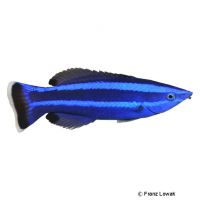Fourline Wrasse (Larabicus quadrilineatus)
| Fourline Wrasse Larabicus quadrilineatus | |
|---|---|
| Name | Fourline Wrasse |
| Name Lat. | Larabicus quadrilineatus |
| Synonym | Labrus quadrilineatus |
| Family | Wrasses |
| Family lat. | Labridae |
| Order | Wrasses & Relatives |
| Order lat. | Labriformes |
| Origin | Red Sea, Gulf of Aden |
| Habitat | Coral reefs, lagoons |
| Diet | Carnivore |
| pH | 8.1-8.4 |
| Hardness | 8-10 °KH |
| Behavior | Semi-aggressive |
| Keeping | Individual, pair, group |
| Reef Compatible | With caution |
| Care Level | Difficult |
| Life Span | N/A |
| Protection | No |
| Metric Units | |
| Size | 12 cm |
| Temperature | 24-28 °C |
| Salinity | 33-36 ‰ |
| Aquarium | ~ 350 l |
| US Units | |
| Size | 5" |
| Temperature | 75-82 °F |
| Salinity | 1.020-1.025 sg |
| Aquarium | ~ 90 gal |
Distribution and habitat
The range of Larabicus quadrilineatus extends from the Red Sea through the Arabian Sea to the western Indian Ocean. They inhabit coral-rich lagoons, reef terraces and shallow outer reefs with coral cover down to 15 m depth.
Maintenance
They need a well structured aquarium with plenty of swimming space and a reef structure (hiding, resting and retreat possibilities) with living stones that act like a biological filter as well as free sand areas (no coral rubble!)
Only substrates rich in lime and free of heavy metals may be used as substrate. Filters, skimmers and heaters are necessary to ensure water quality, as well as pumps to simulate tides, swells and bottom currents. Lighting must match the species-appropriate day-night rhythm of the animals
| Salinity: 33-36 ‰ | pH value: 8.1-8.4 |
| Carbonate hardness: 8-10 °KH | Nitrate content: 2-8 mg/l |
| phosphate content: 0.01-0.1 mg/l | nitrite content: 0.0-0.05 mg/l |
For salinity, an average value should be aimed for, which may only vary slightly by +/- 0.5 ‰. Ammonia and ammonium must not be measurable. Special attention must be paid to constantly good water quality.
Diet
In nature, juveniles feed mainly on parasites that they graze from other fish, adults prefer polyps of stony corals. The food change usually succeeds without problems. The food supply should consist of a combination of mysis, krill, artemia, lobster eggs, shrimp, mussel and crab meat, or a commercially available frozen food mix enriched with vitamins. High-quality flake and granulated food is also often accepted after a period of acclimation
It is recommended to feed small portions several times a day. This reduces intra-species aggression and protects lower animals in the aquarium. Regular and varied feeding promotes health and increases resistance.
Behaviour and compatibility
The young fish, mostly females, are peaceful among themselves and can be kept without problems. With the sex change to male the aggression increases. Males should only be kept singly. However, it is better to keep them in pairs or in a harem, one male with several females. Towards other fish they usually behave peacefully, but they can be perceived as a nuisance due to their intense "preening".
Sex dimorphism
They are protogynous hermaphrodites, i.e. most males develop from functional females as needed and are called "secondary males". These are, not like the black-blue striped juveniles, almost monochromatic dark blue in color.
Reproduction and breeding
There are no known reports of successful breeding in the aquarium
Important
They are very skittish and like to jump, so the aquarium should be well covered
As reef dwellers, they should not be kept in a fish-only aquarium. With sufficient and varied feeding, which also reduces aggressiveness, they can be kept well with invertebrates, except hard corals.
If different species are kept together, care should be taken to match the fish in terms of water quality and temperature requirements and social behavior, and to ensure that the setup meets the needs of all species kept together. Newly introduced fish must be acclimated slowly to the water in the aquarium
Further literature can be found in your pet store
References
Text: Werner Winter; Image: Franz Lowak
Source: KUITER, DEBELIUS (2007): Atlas der Meeresfische: Die Fische an den Küsten der Weltmeere, Kosmos Verlag; BAENSCH & DEBELIUS (2006): Meerwasser Atlas Bd. 1, Mergus Verlag; ENGELMANN (2005): Zootierhaltung - Tiere in menschlicher Obhut: Fische, Verlag Harri Deutsch
